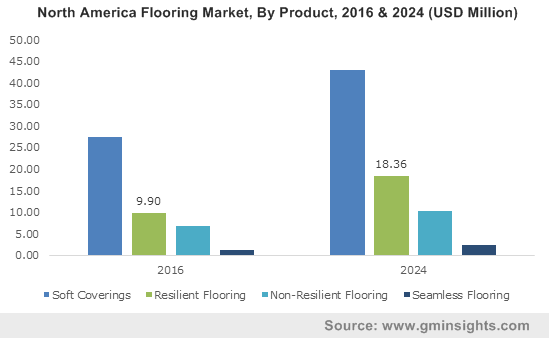Flooring market to gain lucrative avenues from soaring construction sector, Asia Pacific to witness commendable growth over 2017-2024
Publisher : Fractovia | Published Date : 2016-12-09Request Sample
Flooring market is one of the highest potential fraternities in the construction ecosystem that has been witnessing rapid changes over past decades. The advent of several advanced technologies and increasing use of specialized machinery have provided significant impetus to the global flooring market. The extensive rate of construction spending especially with reference to the industrial, commercial, and residential sectors have generated greater demand for flooring products, especially in the emerging markets. As per estimates, the global construction spending is projected to reach around USD 16 trillion by 2024 and was recorded at USD 5 trillion in 2016, which as per analysts, has been proclaimed as primary element driving the growth of flooring industry. In a report provided by Global Market Insights, Inc., flooring market was pegged at USD 270 billion in 2016 and is projected to exceed a massive valuation of USD 450 billion by 2024.
China Flooring Market, By Product, 2012-2024, (USD Billion)

Flooring industry is witnessing a strong application outlook that runs a gamut from residential, hotel, sports, commercial, and healthcare industries. Growing focus on infrastructure development and rising demand for efficient and visually appealing products has further stimulated the growth of flooring market share. Reportedly, flooring market size from industrial applications is expected to be valued at USD 20 billion by 2024, owing to the growing demand for floorings form sectors including oil & gas, mining & metallurgical, chemical, food, and automotive. Beneficial flooring properties which endure heavy duty operations, resistance to high temperature & hazardous chemicals, abrasion, and durability are the key factors that are positively influencing product demand in this sector. Furthermore, rapid urbanization trends and growing construction activities in the commercial arenas have resulted into extensive product penetration driving the commercial flooring market size with an estimated CAGR of 4.5% over 2017-2024.
The global flooring market is highly fragmented due to the presence of larger number of regional and local manufacturers. This is set to generate fierce competition among the industry participants to gain competitive edge and bolster their presence across the globe. Prominent industry players partaking in flooring industry have been aggressively involved in several joint ventures, acquisitions and research and development activities. For instance, Engineered Floors, a renowned floor covering company has settled an agreement to buy its competitor Beaulieu Group, amidst which the former could achieve the 3rd position in the flooring market in terms of sales. In late 2015, Engineered Floors had also announced its plans to unite with J&J Industries – a company that specializes in commercial carpet. Reportedly, the move substantially helped the business player to enhance its regional presence. Some of the other industry players adopting similar growth strategies include Shaw Floors, Forbo, Armstrong, Marazzi Group and Mohawk Industries.
Asia Pacific to be major hub for investments
In 2016, Asia Pacific accounted for more than 32.9% of the global construction industry share and has been rightly touted as an emerging market for floorings. Increasing population and development of manufacturing activities have pushed the construction activities in the region, which in turn has propelled flooring market share. As per statistics, the construction spending in this region was recorded between USD 3-4 trillion in 2016. In fact, Asia Pacific id projected to account for more than 46% of the global construction industry by 2020. China and India are the two prominent regions that are expected to showcase tremendous growth potential with regards to flooring market trends. China is leading the global infrastructure development with an estimation of construction spending close to USD 2 trillion by 2024. One of the factors supporting this huge valuation is China’s National Urbanization Plan for 2014-2020 that was initiated to settle over 100 million urban inhabitants and provide the migrants with housing facilities in the urban areas. This initiative has rose the urbanization rate of China by 60% and has also positively impacted on the growth of China flooring industry.
Go-green notion to drive flooring industry trends
Green building is rapidly gaining popularity in the developed regions, owing to strict regulatory norms and compliances pertaining to minimal environmental impact. Rising trends of sustainable housing has generated greater demand for eco-friendly floor coverings, which in turn have opened up substantial opportunities for the flooring industry players in terms of enhancing their product portfolios. The P.E.T (Polyester) Berber carpet for example is a renowned sustainable flooring carpet that has generated a significant momentum of late. This floor covering is made of recycled plastic bottles and is very durable. Manufacturers have further upgraded the product with spill resistant properties and have offered a variety of aesthetically pleasing colors and patterns. This economical, sustainable, and recyclable flooring option have kept thousands & millions of plastic bottles from dumping in landfills and has conveyed a better logic of protecting the environment. Such developments and green building trends are expected to escalate flooring market trends in the forthcoming years.
Taking in to account these factors and the exponentially rising growth trajectory of flooring business, industry experts estimate flooring market to surpass a massive area of 340 billion square feet by 2024.